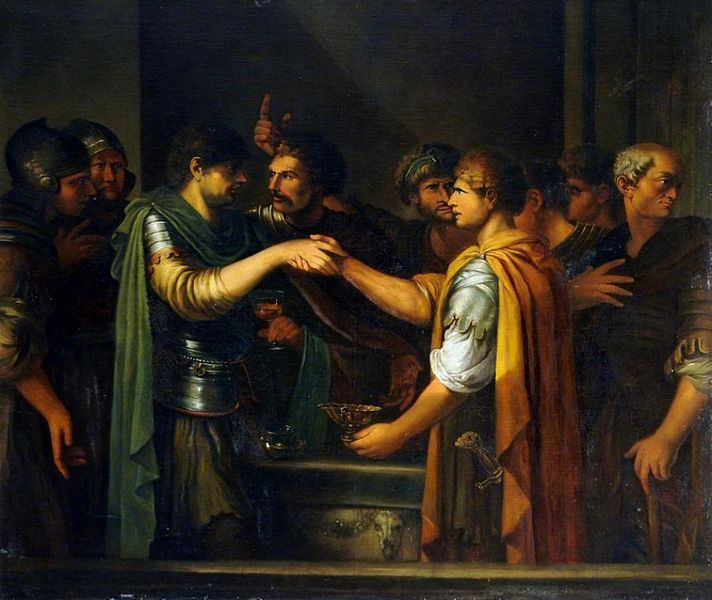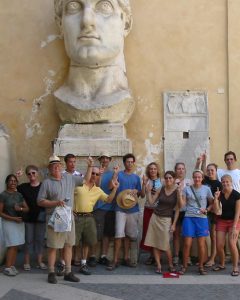Close study of synonyms can reveal much about the language and thought of the ancient Romans, argues Beth Eidam (’20), using the example of words revolving around the concept of “shame”

Some words are innately more poetic than others. Imagine if Robert Frost had opened his iconic poem with “two highways separated in a yellow forest.” Swapping out just a few words for less lovely synonyms changes the entire tone. The line no longer reads like a thoughtful poem but rather a lost traveler describing their predicament. This is the power of vocabulary.
Latin synonyms operate the same way. Ensis (“blade”) serves as the poetic counterpart to prosaic gladius (“sword”), amnis (“torrent”) to flumen (“river”), and virgo (“maiden”) to puella (“girl”). Non-native speakers of Latin (which means all of us) naturally have a hard time hearing these tones and nuances without many years of reading. Modern data science, however, can allow us to immediately perceive and even quantify the level of poeticism in Latin words, thus allowing for a richer appreciation and understanding of Latin texts.
Tessa Cassidy and I created a database of Latin synonyms based on Johann Döderlein’s Handbook of Latin Synonyms (1858), and then added frequency data collected over many years by a Belgian research project called the Laboratory for the Statistical Analysis of Ancient Languages (Laboratoire d’Analyse Statistique des Langues Anciennes or LASLA). Here is a typical entry in Döderlein’s book, discussing the adjectives acer (“keen”) and vehemens (“very eager”):
ACER; VEHEMENS. Acer (ὠκύς) denotes eagerness in a good sense, as fire and energy, in opp. to frigidus, like ὀξύς): but vehemens (ἐχόμενος) in a bad sense, as heat and passion, in opp. to lenis; Cic. Or. ii.49, 53, like σφοδρός. (iv. 450.)[2]
Each synonym is listed with its Greek equivalent and additional Latin words that clarify its meaning when applicable, with English explanations and citations from Latin authors that exemplify the specific meaning he describes. Tessa and I took on the entries in the first half of Döderlein’s handbook, each of us taking responsibility for one quarter of the whole book. My section came out to 546 words.
We then used the LASLA’s Opera Latina interface to query their database and find out how many times each word occurs in prose and poetic texts. LASLA’s database is not totally comprehensive but is nonetheless extensive, containing 2,104,866 word forms, each carefully examined by a scholar to determine which dictionary headword (or “lemma”) it derives from. This made sure, for example, that no instances of the noun acer meaning “maple tree” were mixed up with the instances of acer the adjective meaning “keen.” The LASLA data derives from 154 works by nineteen authors.[3] With the help of LASLA’s lemma search tool, Tessa and I gathered numbers on total uses, prose uses, and poetry uses in the LASLA corpus for each synonym. A sample entry from our data spreadsheet below illustrates how we organized our findings:
| Doederlein lemma | Logeion lemma | LASLA 1 | LASLA 2 | LASLA 3 | total count | prose count | raw poetry count | adjusted poetry count | poeticism score (0-1) |
| ABESSE | ab-sum, abesse, āfuī, āfutūrus | ABSVM | 727 | 509 | 218 | 972 | 0.66 |
The first column lists the form of the dictionary head word (lemma) as listed by Döderlein, the second a full dictionary form as found at the dictionary site Logeion, the third lists the form or forms used by LASLA, followed by the numbers retrieved by searching the lemma(s) in LASLA’s Opera Latina database.
The LASLA database contains more prose than poetry. 1,719,608 word forms derive from prose texts like Cicero’s speeches, while 385,258 are from works, like Vergil’s Aeneid, written in verse. This discrepancy means that the frequency of words in the two genres cannot be compared by the raw numbers. To reconcile this difference, we multiplied the raw number of poetic uses of a word by 4.46, the ratio of total prose uses over poetic in the LASLA corpus. We then used this adjusted poetry count to create a “poetic score” for each word. The score for every word falls between zero and one. A score of one indicates that a word is purely poetic and has no recorded prose uses in the LASLA corpus. The poetic score has allowed us to quickly identify which synonyms were used more often in poetry and which in prose; then the task becomes finding explanations for differences between synonyms.
Although synonyms have overlapping definitions, each conveys a certain nuance and is more apt to be used in different contexts. Acies basically means “a sharp edge,” but has a wide range of definitions, from “sharpness” to “keenness of mind,” “a piercing look,” even “pupil of the eye”; other extensions of the notion of “edge” have a military flavor, such as “a single battle line,” “the whole army,” and “battlefield.” Acies is common, with 654 total uses in the LASLA corpus, evenly distributed in poetry and prose. Its poetic score of 0.50 does not indicate any special poetic or prosaic value. Its synonyms, though rarer in the corpus, have much higher poetic scores. Cacumen carries a more specific sense of “sharpness” with definitions of “peak” and “summit” and has a score of 0.79. Acumen, drawing on the mental nuance of “cunning” or “wit,” has a poetic score of 0.77. Here we see the generality of acies diminishing its poetic score while its synonyms that have more specific senses to their definitions appear more poetic.
This is a phenomenon I observed generally: the breadth or specificity of definitions greatly influence the poeticism of Latin words. Authors all have goals in writing, sometimes to make an argument or tell a story. Whatever the goal, authors choose language that helps achieve their goals. Poets write to convey very specific thoughts and evoke certain emotions, as such, synonyms with more specific qualities to their definition are more useful in poetry than more general counterparts.
Iter is a common word meaning “a going,” “walk,” or “way.” These definitions can expand to “a march,” “a legal right of way,” and “method” or “course.” iter is at home in military writings, legal speeches, and even Horace’s poetic “Journey to Brundisium,” and scores 0.53 on our scale. The more specific synonyms are rarer and more poetic, such as Trames, a “crossroad” (only 29 total uses in the LASLA corpus compared to iter’s 958, but a poetic score of 0.89); and semita, “narrow footpath,” has a poetic score of 0.84. These synonyms were more valuable in poetry as they painted a clearer picture in the reader’s mind than iter with its broad range of definitions. Poets paint vivid images and express very specific ideas in their writing, so it makes sense that words with a stronger ability to convey precise ideas have greater poetic value.
We can use this data to uncover the delicate differences between Latin synonyms for “shame” and clarify the role that these words played in both literature and the value system of Rome. Pudor and its associated adjectives are the key terms for what we call shame. But the terms are culturally specific. According Robert Kaster, the Roman concept of pudor “denotes displeasure with oneself caused by vulnerability to just criticism of a socially diminishing sort.”[4] This kind of shame is reliant on an internal sense of doing what is right and an external force holding individuals accountable. True pudor can only exist with this balance of internal and external pressures. Without an internal moral compass one would only feel shame out of coercion, and without external standards to meet shame would just be a glorified form of self-regard.[5] Pudor is the force that pressures individuals to remain modest and decent, and also the shame that arises from immoral behavior.
Pudor itself has a score of 0.76, which reflects its relatively wide use in prose, compared to the highly poetic adjectival variant pudibundus (1.0). Pudens (“modest,” “bashful”) is neutral (0.49). Pudens represents shame as it is related to reputation.[6] It is applied to individuals who have “a due sense of what one’s position requires” (OLD). Useful in legal cases where character is often an integral feature of a defense or prosecution, pudens is used frequently in Cicero’s speeches (out of 34 total uses of pudens in the LASLA corpus, 26 occur in court speeches of Cicero). In Pro Flacco, a first-century BCE defense of Roman praetor Lucius Valerius Flaccus, Cicero employs the antithesis of pudens and impudens to question the morality of the selected witnesses.[7] Cicero alludes to a rigged trial, calling the selected witnesses impudentes, “dishonorable,” while many other “learned and honorable men were not called to this trial.”[8] Cicero doubts the morality of the trial witnesses, and implies that they do not possess the personal responsibility that pudens evokes. Pudens, therefore, expresses the positive qualities of shame in its ability to produce responsible and respectable individuals. The utility of pudens in legal cases might explain its poetic score of 0.49, the lowest of all the synonyms and the only one with a lower poetic score than pudor.
Seneca the Younger’s play Hercules Furens details the turbulent life of Hercules constantly battling Juno’s hatred. At the climax of the play Hercules is driven to madness by divine power and kills his own wife and children. When his sanity returns to him, Hercules laments the carnage around him and begs his father, Amphitryon, and friend, Theseus, to explain what happened
cur meos Theseus fugit
paterque vultus? ora cur condunt sua?
differte fletus; quis meos dederit neci
omnes simul, profare. quid, genitor, siles?
at tu ede, Theseu, sed tua, Theseu, fide.—
uterque tacitus ora pudibunda obtegit
furtimque lacrimas fundit. in tantis malis
quid est pudendum?
Why do Theseus and my father avoid my sight?
Why do they hide their faces?
Put off your tears. Speak out, who gave
all my (family) to death at once – why are you silent, father?
Then you, Theseus, tell me – by your loyalty, Theseus.
Each man silently covers his ashamed face and
pours out secret tears. What is shameful in such evils? [9]
Pudibundus (1.0) appropriately conveys the intense emotion of this scene in highly poetic terms. Since the adjective expresses a personal shame incited by displeasure in one’s own actions it would be easy to assign it to Hercules, who will spend the rest of the play overwhelmed by shame and guilt. However, Seneca deliberately focuses on the shame of the onlookers. While Amphitryon and Theseus are certainly ashamed on Hercules’ behalf, they are also displeased with themselves. Amphitryon has just witnessed the murders of his grandchildren. Theseus stood by as his friend descended into madness and compromised his honor. Their pudibunda ora show the internal shame they will carry forever from being helpless to intervene. This shame is emotional, personal, and irreparable. The emotional weight of pudibundus explains its only six total uses in the LASLA corpus, all poetic. Poets only employed pudibundus when they wished to convey very specific, personal shame.
Pudicus (“chaste,” and “subdued”) is highly poetic as well, with a score of 0.94. It has connotations of sexual purity. It is applied to bashful and modest individuals uncomfortable in the gaze of others.[10] Pudicus could best be categorized as a derivative of pudicitia, “sexual respectability.”[11] For Roman women especially, it was critical to preserve one’s reputation by being pudica. Conveniently, there were clear social guidelines in Rome on how to be a sexually respectable man or woman.[12] If one simply obeyed social expectations and gender roles, pudicus should be an easily maintainable label. The authors in the LASLA corpus who use it most often are Plautus and Ovid, which makes sense considering Ovid’s often raunchy content. In the Amores, Ovid’s narrator seems unsure that women can truly be pudica, but nonetheless asks that his interests at least feign that kind of modesty.
Non ego, ne pecces, cum sis formosa, recuso,
sed ne sit misero scire necesse mihi;
nec te nostra iubet fieri censura pudicam,
sed tamen, ut temptes dissimulare, rogat.
Since you are beautiful I do not ask that you not err,
but that it not be necessary for me, a wretch, to know;
nor does my censure demand that you become chaste,
but nevertheless, I ask that you attempt to not let it show.[13]
Ovid assumes that the object of his affection cannot truly be pudica because of her appearance, but he does not seem to care. If her reputation is intact it does not matter what she has done. Ovid’s concern further emphasizes that all kinds of shame in Rome were deeply intertwined with reputation and illustrates the role of external accountability in Kaster’s definition of pudor. Ovid declares that pudicus is determined not only by one’s actual actions, but by how others see and judge those actions. An individual can only be pudicus if the public regards them as such.
Another adjective meaning “possessed of shame” is castus (0.93). If pudicus is in the eye of the beholder, castus, as defined by Döderlein, refers to “chastity as a natural quality of the soul.”[14] It is a cousin of careo, the verb meaning “to be free from,” and castus the much rarer noun meaning “abstinence.”[15] Castus includes the sexual implications of pudicus but intertwines those nuances with personal character, not social reputation as pudicus does. Not only is a castus individual pure in a sexual sense, but they are clean of any moral stain by nature. In this way castus is almost the perfect combination of the nuances of pudicus and pudens.
Ovid and Propertius employ castus frequently, which is not surprising considering the focus of their poems on love and relationships. Propertius describes a happy couple in his Elegies, “O Postumus, [you are] blessed three and four times over in Galla’s chastity.”[16] The poem continues to praise Galla’s purity and inability to be corrupted in any way, even describing her as pudica a few lines down.
The value of shame in Rome was demanding yet vague. Individuals were expected to uphold a certain set of standards, but those standards could not be clarified by one word. The general nature of pudor’s definition begs for synonyms to clarify each facet of the value. Pudens, pudibundus, pudicus, and castus exemplify the value that nuance in synonyms had in literature, but they also reveal a greater poetic tendency to favor synonyms that convey a more specific sense of the general concept.
[2] Johann Döderlein. Döderlein’s Book of Latin Synonymes. Trans. by Rev. H.H. Arnold. Andover: Warren Draper, 1858. 3.
[3] Prose authors: Caesar, Cato, Curtius, Petronius, Plinius (the Younger), Sallustius, Seneca (Apocolocyntosis through De Vita Beata), Tacitus, Cicero. Poetry authors: Catullus, Horatius, Juvenalis, Lucretius, Ovidius, Persius, Plautus, Propertius, Seneca (Hercules Furens through Hercules Oetaeus), Tibullus, Vergilius
[4] Kaster, 4.
[5] Kaster, 8.
[6] Döderlein, 34.
[7] Pro Flacco, 9.8.
[8] Pro Flacco, 9.8. “…docti, pudentes, qui ad hoc iudicium deducti not sunt.” Author’s own translation.
[9] Hercules Furens, 1178. Author’s own translation.
[10] Döderlein, 34.
[11] Kaster, 9-10.
[12] Kaster, 10.
[13] Amores, 3.14.3. Author’s own translation.
[14] Döderlein, 34.
[15] Thesaurus Linguae Latinae.
[16] Elegiae, 3.12.15. “ter quater in casta felix, o Postume, Galla” Author’s own translation.












